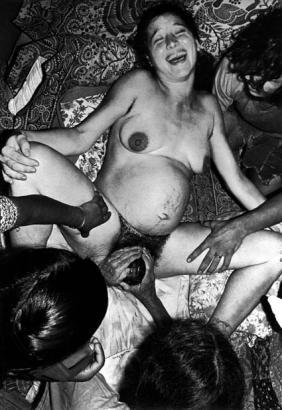Terese Crowning – An Image of Ecstatic Birth
In this image, taken originally from Ina May Gaskin’s, Guide to Childbirth (2003), and found on the Birth Rites website, a woman named Terese gives birth to her first child, an eight-pound baby, after twenty-four hours of labor.[1] Photographed as her baby was crowning, the image contradicts the societal insinuation that birth must be painful. Terese is also a slim woman. Thus the happy crowning of her child contradicts the idea that small women cannot birth comfortably.
Quite frequently, women who choose to birth their children naturally are described in our culture as crazy, masochistic or tough since they have decided to “endure the pain of birth.” In fact, although some amount of pain is a part of the birth experience for many women who give birth naturally, the categorization of these women in such a way overemphasizes the role that pain plays in the birthing process. While working both as a student and a battlefield doctor with women in different environments around the world, Dr. Grantly Dick-Read, a pioneer of the natural birth movement, famously realized in the early twentieth-century (first discovered during his training in London in 1913) that there was a direct connection between fear of birth and pain felt in labor. The more tense and fearful a woman was of giving birth, the more likely it was that she would report having felt pain during the process.[2] Dick-Read encountered many women who chose not to undergo any interventions during birth (e.g. use of chloroform), approaching birth in a matter-of-fact manner, and yet who also appeared to experience birth much less painfully than did the women who were frightened of labor and asked for treatment..[3]
We now know that relaxation exercises are very important to an easier and more relaxed birth experience—for both mother and child. Although the sensations that a woman feels during labor can be highly uncomfortable and painful too, her ability to trust her body, breathe and relax enables her to diminish her pain and focus on her emerging baby. And in fact, as is seen in this photo of Terese, birth need not be a painful event for some! Terese had a drug-free birth. Thus her ecstasy is a natural ecstasy, experienced as nature takes its course and she welcomes her baby into the world.[3]
As Ina May explains, there are cases that she has seen in her many years as a midwife in which a woman not only does not experience pain during birth, but actually experiences ecstasy in the process.[4] The recent movie, Orgasmic Birth, has footage that attests to this. These ecstatic births most often occur when the woman is relaxed and unafraid of labor. Regardless of whether a woman experiences ecstasy or not during labor, however, it is clear that relaxation reduces pain and makes birth very manageable for the woman who births naturally.
An image such as the photo of Terese is very empowering and calming for the pregnant woman, encouraging her not to be afraid. Such a photo also helps others to transform their understandings of what it is to give birth.
[1] Ina May Gaskin, Ina May’s Guide to Childbirth, New York: Bantam, 2003, 162-163.
[2] Ibid 150-156.
.[3] Ibid 155.
[3] Ibid 163.
[4] Ibid.
